BY: PAMELA SCHAEFFER, PhD
By the early 1990s, economic and social changes, including rapidly escalating health care costs and a widening income gap between rich and poor, made access to health care increasingly problematic for growing numbers of people who lacked health insurance. This was a problem CHA already had begun to address with its 1986 landmark document called No Room in the Marketplace: The Health Care of the Poor. This document, the work of the CHA Task Force on Health Care of the Poor, was rooted in Catholic health care's historic concern for the poor and the Catholic view that health care is a basic human right. These beliefs would fuel CHA's push for comprehensive health reform over the next two-and-a-half decades.
By the early 1990s, public opinion polls showed that Americans had become more worried about losing health benefits and being unable to pay medical bills in the future. Businesses, meanwhile, were balking at rising health insurance premiums, and organized labor was concerned about growing out-of-pocket health care costs for workers. Companies with international business connections worried about their ability to compete globally. Even some health care groups formerly opposed to national health insurance reconsidered and joined the movement for reform.
The task force that developed No Room in the Marketplace had found the political environment unfavorable to comprehensive reform and recommended an interim, incremental strategy based on limited government programs to help the poor. Just a few years later, though, the political environment shifted. In the early 1990s, with a push from newly elected President Bill Clinton, comprehensive health care reform seemed more possible.
CHA's work in the late 1980s ensured the association and its members a strong role in the national debates that followed. Building on that groundwork, CHA in 1990 began what would become an intense, well-organized and widespread campaign to reduce health care costs, tie costs to favorable health outcomes and ensure that all Americans received good health care regardless of their ability to pay.
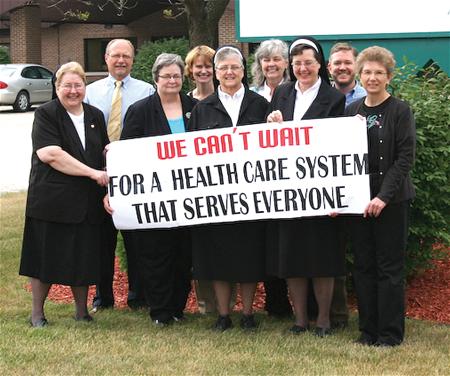
Staff at the Franciscan Sisters of Christian Charity system headquarters in Manitowoc, Wis., gathered in 2009 to show their support for health care reform in the "I Can't Wait" campaign. Pictured from left: Sr. Laura Wolf, James Vopat, Karen Aasen, Barbara Kane, Sr. Helena Young, Jean Stecker, Sr. Patricia Linssen, Scott McConnaha, and Michele Ziarnik.
IDENTIFYING PRINCIPLES
An early step in that campaign was appointment of a new CHA committee, The Select Committee on Indigent Care, which was charged with developing foundational principles against which proposals could be evaluated. The committee convened a symposium of Catholic leaders at Georgetown University in 1989 to consider the social, religious, economic and political implications of various reform proposals, and it published the results the next year in Charting the Future: Principles for Systemic Healthcare Reform. The document contained nine principles flowing from two basic theological tenets: the inherent dignity of all human beings, because they are created in the image of God; and the belief, rooted in Catholic social teaching, that society should be organized to ensure basic human rights, including a right to health care.
In her July 1990 testimony before the U.S. House Ways and Means Committee's subcommittee on health, Sr. Mary Roch Rocklage, RSM, head of the Select Committee on Indigent Care, said universal access to health care was CHA's highest public policy priority. It was time for the U.S. to "join the rest of the world's industrialized nations in establishing a national health program," she said.
CHA's national health policy project was planned to roll out in three phases. The first was to identify principles, the second to analyze current proposals for systemic reform and the third to develop specific recommendations for change.
For the second phase, CHA engaged the Washington, D.C.-based Lewin-ICF (formerly the Lewin Group) to assist in determining how various reform proposals would affect Catholic health care facilities from both mission and financial standpoints.
Principles for Systemic Health Care ReformAn outcome of the Georgetown Symposium were nine principles, which became the policy directive for CHA's ongoing advocacy. They called for - Basic comprehensive benefits to ensure good health and appropriate treatment of disease
- Shared responsibility for providing health care among all sectors of society
- Guarantee of all parties to free exercise of their ethical and religious beliefs
- Allocation of resources according to community needs
- Broad community participation in identifying needs and establishing priorities
- Public policies to ensure quality care
- A federally ensured financing mechanism
- Responsive, cost-effective administration
|
DEVELOPING POLICY
To accomplish the third phase, CHA president and CEO Jack Curley appointed a Leadership Task Force on National Health Policy Reform to formulate and submit specific policy recommendations to CHA's Board of Trustees. The task force was headed by Sr. Bernice Coreil, DC.
In the summer of 1991, the Leadership Task Force learned from regional focus groups that CHA members strongly believed reform should be values-based, putting the needs of people above those of institutions.
To begin forging a reform consensus, some CHA staff members met with key government committees and leaders of several professional organizations. Meanwhile, the Leadership Task Force worked to fine-tune its proposal based on continued member input. In late February 1992, the board adopted the results of the committee's work in the landmark report Setting Relationship Right: A Working Proposal for Systemic Healthcare Reform. The board described it as a proposal "that starts with the needs of people in contrast to other plans which begin with financing."
The proposal involved a combination of public and private financing mechanisms.
Meanwhile, President George H. W. Bush and U.S. Catholic bishops entered the arena. Bush, early in 1992, his last year in office, proposed tax credits for poor people who purchased health insurance. The credits would be financed by cutting Medicaid and Medicare budgets.
Although CHA appreciated the president's interest, the association, along with many others, was critical of his plan. Jack Curley described it as "superficial at best," and Sr. Coreil said it failed to address the issues of cost, quality and fragmentation of the health care delivery system. The plan would pour "more money from the wrong sources into a broken system where quality is not improved, cost is not contained, and people are not better served," she said.
REFORM HOPES RISE
Nevertheless, reform momentum was building. As Sr. Coreil told the CHA board in February 1992, the health care reform debate in the United States "is being driven by profound social and economic changes," and she affirmed that CHA's role was critical for two reasons: to infuse the debate with Catholic health care's values and to influence the outcome, which would have "a profound impact on the future of the ministry itself."
When Bill Clinton was elected president in 1992, reform hopes ran high. Clinton had run on a platform of economic and health care reform and promised to make universal health care a cornerstone of domestic policy during his first term of office.
Soon after his inauguration in January 1993, Clinton established the Task Force on National Health Reform and appointed first lady Hillary Rodham Clinton to run it. The task force was charged with developing a plan to make universal health care a reality.
Pledging to work with the administration on reform, CHA expanded its educational and advocacy efforts. In conjunction with other groups, it sponsored a bipartisan retreat for senior congressional health staff members and workshops for bishops.
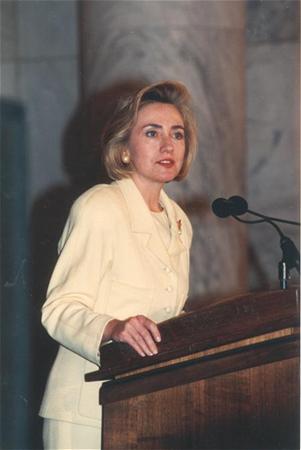
First lady Hillary Rodham Clinton
HILLARY CLINTON GETS TO WORK
Hillary Clinton created more than 30 working groups to address specific reform issues. CHA was deeply involved. Sr. Coreil served on a panel representing hospital groups, and CHA identified diverse representatives, from Catholic health care leaders to bishops, to testify to relevant Congressional committees on behalf of CHA's reform proposal.
In May 1993, Jack Curley and top CHA leaders met with Donna Shalala, U.S. Secretary of Health and Human Services, to present highlights from its working health care reform proposal. Then in October, CHA joined two other organizations — the D.C.-based Alliance for Health Care Reform and the California-based Kaiser Family Foundation — in sponsoring a debate among leading health care policy makers on the Clinton plan and major alternatives. The program attracted nearly 200 congressional staffers and journalists.
When President Clinton unveiled his administration's health reform proposal in September 1993, it had many elements in common with CHA's proposal. Both plans would provide for universal access, establish a national health board to control growth and spending and depend on integrated delivery networks (the Clinton plan referred to them as "managed care"). Among the differences, the Clinton plan would require employers to contribute to the cost of employee premiums, and competition among networks would be based on price rather than quality and service. While the Clinton plan would permit fee-for-service medicine to continue, it included strong incentives to use the networks.
In December, President Clinton made health care reform the topic of a major address to Congress. That same month, CHA unveiled an aggressive grassroots lobbying initiative with the aim of supporting, and improving, the Clinton proposal.
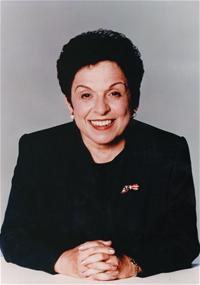
U.S. Secretary of Health and Human Services Donna Shalala
CHA's advocacy strategy at this point was to target members of five key congressional committees to support the overall direction of the Clinton plan and propose several improvements. Key among those improvements were a stronger focus on delivery system reform, no requirement to provide abortions and inclusion of a strong conscience clause for individuals, institutions and employers to ensure that Catholic health care could maintain its Catholic identity in a reformed system.
In late 1992 through 1993, CHA continued to refine its own proposal and, based on member input, to review whether employer-based financing and price-based competition could be incorporated into the plan.
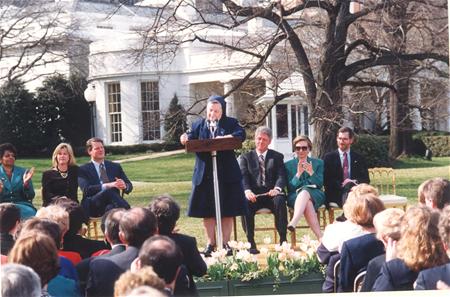
Sr. Bernice Coreil, DC, flanked by Vice President Al Gore, Tipper Gore and President Bill Clinton and Hillary Rodham Clinton, addressed a gathering of health care professionals on the White House lawn in 1994.
Widespread member education was the next major undertaking for CHA. Some board members noted that CHA's plan required a major shift in mindset for member organizations, from a focus on acute care to one on integrated delivery networks, and that member organizations that moved too slowly could be left behind. To address that concern, CHA began in 1994 to offer meetings for member leadership teams around the country to help them assess their readiness to make the shift and develop action plans.
In spring of 1994, Sr. Coreil was one of three representatives of health care providers chosen to address a White House gathering of 200 health care professionals and to introduce the president and first lady to the group. The audience included hospital administrators, physicians, nurses, social workers and pharmacists who favored universal coverage.The Leadership Task Force followed up its document Setting Relationships Right with an educational resource for members titled A Primer on Health Care Reform.
In August, CHA joined 36 organizations of health care professionals at a rally in Washington D.C. to show support for universal coverage. Sr. Laura Wolf, president of the Franciscan Sisters of Christian Charity, Manitowoc, Wis., represented CHA. Later that month, CHA officials met with the president and first lady for nearly an hour in the Oval Office to discuss reform. The Clintons praised CHA for a study it had sponsored showing that incremental approaches to reform would have a detrimental effect on the middle class compared to the positive effect of universal coverage.
Despite so many efforts and so much productive dialogue, however, strong opposition to the reform proposal came from virtually every sector of society. Congress defeated the Clinton health care reform bill in September 1994.
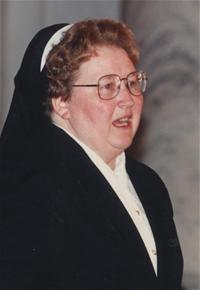
Sr. Laura Wolf, OSF
SHIFT IN STRATEGY
President Clinton did not attempt to resurrect his goal of universal health care in the rest of his first term, nor in his second term. Instead he turned his attention to other domestic issues, especially the economy and welfare reform.
CHA lent its support to some interim health reform measures, including the Health Insurance Portability and Accountability Act in 1996, which enables employees to keep their health coverage when changing jobs.
In 1997, Congress passed the State Children's Health Insurance Program (SCHIP, or CHIP), another measure strongly supported by CHA. Administered by the U.S. Department of Health and Human Services, the federal-state program provides affordable health insurance to children in modest-income families who do not qualify for Medicaid.
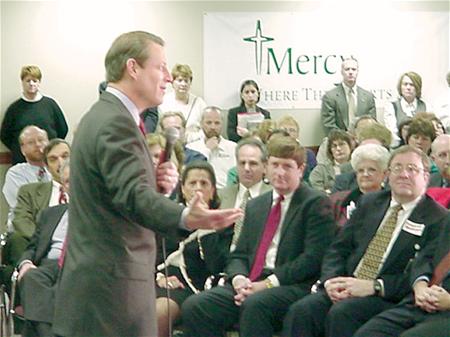
Vice President Al Gore made Mercy Medical Center in Des Moines, Iowa, the setting to outline his ideas for expanding Medicaid and the Children's Health Insurance Program (CHIP).
RENEWED PUSH, DIFFERENT APPROACH
When Fr. Michael Place succeeded Jack Curley as CHA president and CEO in 1998, he continued to lead the charge for health care reform. With universal coverage at the top of CHA's advocacy agenda, the CHA board at its February 1998 meeting called for a coherent long-term vision of systemic reform as well as short-term strategies to maintain, then expand, health care for low- and moderate-income families.
During the 2000 presidential campaign, CHA asked each candidate to make health care reform a campaign issue and to pledge, if elected, to make a priority of accessible, affordable health care for everyone. At a press conference in early May, Fr. Place highlighted a letter from CHA to potential candidates reminding them that more than 40 million Americans lacked health insurance — a number growing at a rate of nearly 1.2 million a year — and pointed to the declining number of employers providing health insurance for employees. At the 2000 Catholic Health Assembly in June, an electronic poll of attendees showed broad agreement that the health care system was flawed and that health care is a basic human right.
In September 1999, Fr. Place appointed a new CHA committee to recommend elements of reform but without the specificity of the previous proposal, Setting Relationships Right. The board accepted the committee's recommendations in April 2000, adopting a public policy position that generally supported the recommendations in the November 1999, Institute of Medicine report, To Err Is Human: Building a Safer Health System.
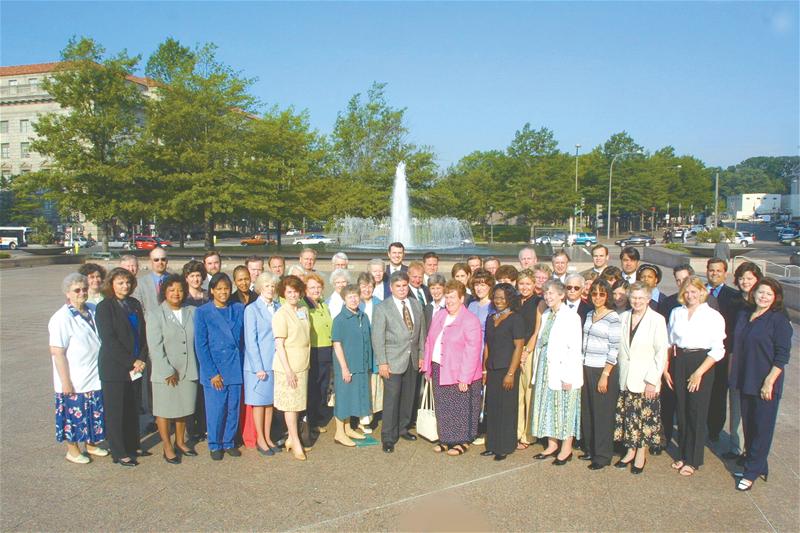
More than 100 executives representing 17 Catholic health care systems across the United States came to Washington, DC in April 2002 for CHA Advocacy Days. Many of them gathered briefly in Freedom Plaza before heading to their meetings on Capitol Hill.
MOVEMENT STALLED
George W. Bush took office in January 2001, and nine months later was confronted with the deadliest attack on U.S. soil in the country's history. Partially as a result of those attacks, now known simply as 9/11, and the subsequent war against Iraq, President Bush devoted little attention to health care reform during his first term in office, although he did sign into law the Medicare Modernization Act, which provided prescription drug benefits to seniors.
Three months after 9/11, in December 2001, Fr. Place vowed that until health reform again became a national priority, CHA would be the "fingernail on the blackboard" on behalf of the uninsured. It was clear that an ongoing, multi-year commitment employing a variety of strategies would be needed in order for health reform to become a reality.
As the session of Congress opened in January 2002, results of the 2000 U.S. Census confirmed that the number of uninsured in the U.S. had increased to 41 million. Michael F. Rodgers, CHA's new vice-president of public policy and advocacy, promised that, as the ranks of the uninsured were continuing to grow, CHA would stay on target with its reform focus.
The following month, CHA joined 12 other organizations —health, civic, business and labor — to invest in a multi-million-dollar advertising campaign to call attention to the uninsured. With the advertising campaign focused on influencing public opinion, CHA's advocacy staff under Rodgers' leadership kept the pressure on Congress and the president.
In April 2002, CHA launched what would become the annual Catholic Health Care Advocacy Days, bringing together in Washington D.C. executives from Catholic health care systems to meet with more than 130 members of Congress and their staffs. CHA's priorities for the meetings included coverage for the uninsured, fair and adequate payments for providers, improvements to the health care safety net for the poor and assurance that conscience clause protections would be part of any reform bill.
CHA's strategic plan for 2003-2005 called for members as "the ministry engaged" to forge strong collaborative bonds in order to transform health care. The plan called for full coverage of the nation's uninsured by December 2008.
 Beginning in 2003, CHA participated with other national organizations in a major campaign sponsored by the Robert Wood Johnson Foundation to build awareness of the plight of the uninsured. Known as "Cover the Uninsured Week," it was held annually through 2010. In those eight years, CHA members sponsored thousands of events, from free health screenings to town hall meetings with business and political leaders.
Beginning in 2003, CHA participated with other national organizations in a major campaign sponsored by the Robert Wood Johnson Foundation to build awareness of the plight of the uninsured. Known as "Cover the Uninsured Week," it was held annually through 2010. In those eight years, CHA members sponsored thousands of events, from free health screenings to town hall meetings with business and political leaders.
When Sr. Carol Keehan, DC, succeeded Fr. Place as CHA's president and chief executive officer in 2005, she promised to work unceasingly for CHA's ongoing quest for universal coverage.
VISION LAYS OUT STEPS
In 2004, Fr. Place initiated an effort focused on persuading lawmakers and citizens alike that health reform was a moral and economic imperative. A task force created under the title "Covering a Nation" developed communications resources and focused

Harry and Louise, the fictional couple featured in television ads to derail the Clinton health reform plan in the 1990s, revised their thinking to support reform in 2008.
on public speaking and outreach to engage CHA members in making health reform a top national priority. In January 2008, the Covering a Nation task force released "Our Vision for US Health Care," a set of value-based criteria for a redesigned health care system. The document enumerates principles to follow when developing legislation to improve the health care system — beginning with coverage for everyone. The principles also called for a renewed focus on prevention, greater efforts to promote transparency and rigorous attention to quality. A related video to inspire the ministry, "One Voice Can Reform Healthcare — Yours," was introduced at the 2008 Assembly.
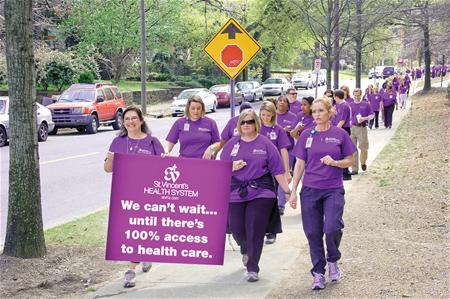
Associates of St. Vincent's Health System in Birmingham, Ala., participated in the "I Can't Wait" campaign, which relied on CHA members to help spread the word about the importance of health reform.
In the months leading up to the 2008 presidential election, CHA was one of five national organizations that joined together in the "Health Care First" coalition to sponsor a national advertising campaign about the urgent need for health reform. The main commercial featured Harry and Louise, a fictional couple who had helped derail the Clinton plan in the 1990s. In a creative twist on that effort, the new campaign told television viewers, "Harry and Louise are back — and they support health reform." The TV ads, which ran throughout the Democratic and Republican conventions, asserted that Harry and Louise now believed health care reform should be a top priority for the next U.S. president.
NEW ADMINISTRATION, NEW HOPE
The election of President Barack Obama in November 2008 gave new hope to health reform supporters. Among his campaign promises, Obama had proposed a plan for universal coverage. After taking office in January 2009, he made it a priority of his first-year domestic agenda. Sr. Keehan was one of 120 leaders, including 64 members of Congress, invited to the White House for Obama's first formal working session on reform. She and other CHA staff worked diligently from that point on, in private and public forums, to garner Catholic, public and legislative support for reform as Congress prepared and debated provisions of a prospective bill.
Among CHA's creative programs around this time was the "I Can't Wait" campaign, a grassroots communications effort involving CHA members. CHA invited people from member organizations to submit photographs of themselves holding signs beginning with the words, "I Can't Wait," then completing the sentence with their hopes or expectations for health reform. CHA selected from hundreds of photos and compiled them in a video that was first shown before reform was passed. The short video was shown to President Obama and featured on a network news broadcast.
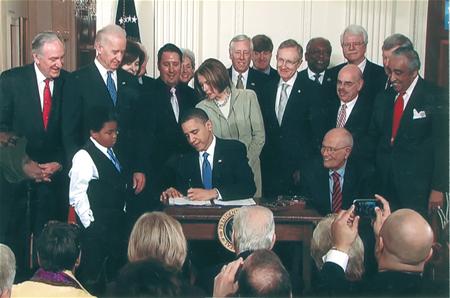
President Barack Obama, surrounded by lawmakers and guests, signs the Patient Protection and Affordable Care Act during a March 23, 2010, ceremony in the East Room of the White House.
When President Obama signed the Patient Protection and Affordable Care Act into law on March 23, 2010, it was the most sweeping reform to the U.S. health care system since Medicare and Medicaid were created in 1965. The bill garnered widespread opposition, both before and after its passage. CHA, among many other supporting organizations, fought hard against daunting odds to ensure its passage and to head off efforts to dismantle the plan after it became law.
The question of federal funding of abortion was among the challenging issues that had to be addressed. Both CHA and U.S. Catholic bishops had always agreed on the fundamental goal of ensuring that no federal dollars ever be used to finance abortions. Based on extensive legal research, CHA had concluded that the bill as written did prevent federal funding of abortion. Analysis conducted by the United States Conference of Catholic Bishops reached a different conclusion. The bishops believed that the bill could allow federal funding of abortion. "People of good will can differ on evaluating the effectiveness of legislative language," Sr. Keehan wrote at the time.
In connection with the bill signing, President Obama issued an executive order reinforcing a commitment in the Affordable Care Act to the 1976 Hyde Amendment, a legislative provision that bans federal funds for abortion except in cases of rape or incest.
Once the law was in effect, another difficult issue centered on insurance coverage of contraceptive services. The Institute of Medicine, charged with recommending guidelines in the ACA for coverage of women's preventive health services, had recommended that the bill provide for complete and free coverage of most contraceptive services under health benefit plans. This provision, once adopted, became a problem for organizations that object to providing contraceptive services through their insurance plans.
CHA urged the Obama administration to exempt all nonprofit, Catholic employers from the requirement. The final rule included an accommodation whereby CHA members would not have to pay for, provide or arrange contraceptive coverage for their employees. While CHA viewed the accommodation as less than perfect, it was regarded as workable for the association's members. The USCCB continued to express broader concerns with the mandate based on issues of religious freedom.
SUCCESS AT LAST
CHA's continued support of the health reform bill at these critical junctures helped ensure its passage. Administration officials and members of Congress who supported the ACA praised the association's long commitment to advocating for reform and described CHA's role as crucial in the final weeks of debate leading up to the vote. Sr. Keehan was given one of the 22 pens President Obama had used to sign the ACA into law.
Although the law fell short of providing universal coverage, it stood to help some 31 million Americans who were previously uninsured. In a statement, Sr. Keehan described the ACA's passage as "a victory for the American people, for the poor, for families struggling to obtain coverage and for the long-term strength of our health care system."
In a column published in Catholic Health World, she said the two weeks leading up to the passage of the Affordable Care Act had been "among the most challenging in CHA's history."
"We shared with so many a desire that finally people in this country would have access to health care," Sr. Keehan said. "We had a vision for health reform that outlined our non-negotiables and among these was respect for the life and dignity of all from conception to natural death."
Although challenges lay ahead, CHA could rejoice that, at the approach of its 100th anniversary in 2015 the Affordable Care Act had expanded coverage to at least 20 million people who previously did not have meaningful, affordable health insurance. CHA's persistent efforts over the decades significantly contributed to that success.
PAMELA SCHAEFFER is a former editor of Health Progress.